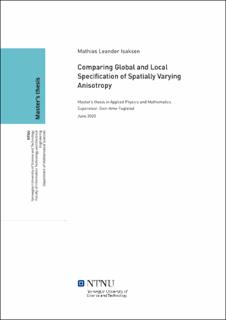| dc.contributor.advisor | Fuglstad, Geir-Arne | |
| dc.contributor.author | Isaksen, Mathias Leander | |
| dc.date.accessioned | 2021-09-15T17:26:12Z | |
| dc.date.available | 2021-09-15T17:26:12Z | |
| dc.date.issued | 2020 | |
| dc.identifier | no.ntnu:inspera:55607230:37672399 | |
| dc.identifier.uri | https://hdl.handle.net/11250/2778340 | |
| dc.description.abstract | I denne oppgaven tar vi for oss to tilnærminger til ikke-stasjonær romlig modellering med gaussiske stokastiske felt (GRF-er), og sammenligner disse.
Den første tilnærmingen tar i bruk en stokastisk partiell differensialligning (SPDE), som har en GRF som løsning.
Ved å diskretisere likningen, får vi en beregningsmessig effektiv Gaussian Markov random field-tilnærming (GMRF).
Den ikke-stasjonære kovariansstrukturen kontrolleres gjennom de romlig varierende koeffisientene til SPDE-en.
Inferens og prediksjon utføres med R-pakka R-INLA, som er en implementasjon av Integrated Nested Laplace Approximation-rammeverket (INLA).
I den andre tilnærmingen uttrykkes GRF-en som en konvolusjon mellom romlig varierende kernelfunksjoner og gaussisk hvit støy, som fører til at den ikke-stasjonære kovariansfunksjonen er indirekte spesifisert gjennom kernelfunksjonene.
Her bruker vi R-pakka BayesNSGP, som er dedikert til ikke-stasjonær modellering med den kernel-baserte tilnærmingen.
De SPDE- og kernel-baserte tilnærmingene presenteres, og vi beskriver stasjonære og ikke-stasjonære parametriseringer.
Ikke-stasjonæriteten modelleres gjennom regresjon på romlige kovariater, som fører til en lite fleksibel spesifisering av kovariansstrukturen.
Den ikke-stasjonære SPDE-modellen og tilhørende parametriseringer implementeres i R-INLA.
Parametriseringene som beskrives for den kernel-baserte tilnærmingen er ikke tilgjengelige i BayesNSGP, og implementeres manuelt.
De to tilnærmingene sammenlignes både kvalitativt og kvantitativt.
Modellenes inferensegenskaper og prediktive evner undersøkes først gjennom et simulasjonsstudie, hvor de observerte dataene genereres fra en kjent prosess.
Deretter utfører vi et casestudie, hvor vi tar for oss nedbørsdata fra det kontinentale USA (CONUS).
Resultatene fra simulasjonsstudiet indikerer at det finnes situasjoner hvor den ene tilnærmingen er mer egnet enn den andre.
Vi tar for oss en situasjon hvor de to tilnærmingene fører til kvalitativt forskjellige kovariansstrukturer, og demonstrerer at tilnærmingen med den riktige strukturen fører til bedre resultater.
Videre har de stasjonære modellene betraktelig dårligere resultater enn de ikke-stasjonære, når de observerte dataene genereres fra en ikke-stasjonær prosess.
I casestudiet er derimot forskjellene mellom de stasjonære og ikke-stasjonære modellene mindre.
De SPDE-baserte modellene fører til marginalt bedre resultater, og har vesentlig kortere kjøretid enn de tilsvarende kernel-baserte modellene.
Mens disse resultatene indikerer at den SPDE-baserte tilnærmingen bør foretrekkes, foreslår vi at det må utføres mer utforskning før pålitelige konklusjoner kan trekkes. | |
| dc.description.abstract | In this thesis, we consider and compare two approaches for non-stationary spatial modeling with Gaussian random fields (GRFs).
The first is based on a stochastic partial differential equation (SPDE) with a GRF as its solution.
Through discretization, a computationally efficient Gaussian Markov random field (GMRF) approximation is obtained.
The non-stationary covariance structure is controlled through the spatially varying coefficients of the SPDE.
The R package R-INLA, which is an implementation of the Integrated Nested Laplace Approximation (INLA) framework, is used for performing inference and prediction.
In the second approach, the GRF is expressed as a convolution between spatially varying kernel functions and Gaussian white noise, so that the non-stationary covariance function is specified indirectly through the kernel functions.
For this approach we use the R package BayesNSGP, which is dedicated to non-stationary modeling with the kernel-based method.
The SPDE- and kernel-based approaches are presented, and we describe stationary and non-stationary parametrizations.
The non-stationarity is modeled through regression on spatial covariates, resulting in an inflexible specification of the covariance structure.
The non-stationary SPDE model is implemented in R-INLA, along with the parametrizations.
The parametrizations used for the kernel-based approach are not available in BayesNSGP, and are implemented manually.
We compare the two approaches both qualitatively and quantitatively.
The inferential properties and predictive power of the models are first investigated through a simulation study, where the observed data is generated from a known process.
Afterwards, a case study is carried out with precipitation data from the contiguous United States (CONUS).
The results from the simulation study indicate that there are situations where one approach is more appropriate than the other.
In particular, we consider a situation were the approaches lead to qualitatively different covariance structures, and demonstrate that the approach with the correct one performs better.
Further, when the observed data is generated from a non-stationary process, the stationary models perform considerably worse than the non-stationary models.
In the case study, however, the differences between the stationary and non-stationary models are less dramatic.
The SPDE-based models lead to marginally better results, and have considerably faster run-times than the corresponding kernel-based models.
While these results indicate that the SPDE-based approach should be preferred, we suggest that more investigation is necessary before any reliable conclusions can be made. | |
| dc.language | | |
| dc.publisher | NTNU | |
| dc.title | Comparing Global and Local Specification of Spatially Varying Anisotropy | |
| dc.type | Master thesis | |
